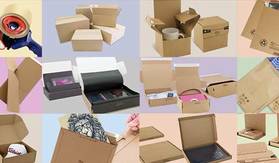
Our top five most common sustainable packaging mistakes
Switching to sustainable packaging doesn't just do the planet good, it also makes perfect business sense. Greener packaging can make your shipping process more efficient through less waste and lower costs, and your customers might even appreciate it too. In fact, 66% of consumers say they'll pay more for sustainable goods, a figure that rises to 73% for Millennials. So if sustainable packaging is such a good idea, why don't more brands make the switch? Here are the most common pitfalls businesses overlook along with tips on how to avoid them.
1 - Your boxes are too big for the items you're shipping
If your boxes are too big, it can hamper your efforts to become sustainable on several fronts. This is often because:- It inflates your resources carbon footprint: a square-inch or two of extra cardboard might not seem like much. Multiply that over hundreds or thousands of packages, though? That's a lot of material!
- It creates 'dead air': with fragile products, any space left in the delivery package has to be filled to prevent items from rattling around in transit. The more unfilled space there is, the more filler material you need to protect your products.
- Shipping and storage: the bigger your parcels, the fewer you can fit into the delivery van. Oversized packages may have you paying more shipping costs than necessary. Making the switch to more compact packaging units means storing your business' packaging will become a lot easier.

2 - You're using mixed packaging
Sometimes, a packaging design starts off eco-friendly but careless additions like polymer tie straps, cellophane viewing panes, and foil inserts will make them unsustainable again. Mixing packaging materials can leave customers confused about what can or can't be recycled. That's why it's important to keep the packaging design as simple as possible. If you need multiple materials per package, opt for similar materials that can be recycled together (a corrugated box with paper lining, for instance).
3 - Wasteful returns
As well as eating into your profits, a high rate of returned products leads to more funds spent on shipping, product repair, and replacement. It's wasteful, inefficient, and can contribute significantly to your environmental footprint. So is your packaging helping or hindering the returns process? Here are two key questions to consider:
Is the packaging strong enough to ensure safe delivery? Not enough packaging is just as wasteful as too much (especially if it gives rise to frequent returns of damaged goods). For heavier or more delicate items, good quality, double-walled cardboard boxes are worth investing in for the sake of your product's safety.
Does it make returns easier? As a customer, fighting to open packaging and get to your new purchase can be frustrating. It becomes doubly annoying if your order isn't quite right, as you've just destroyed the box to return it! Resealable mailer bags and flip top, pop-up mailboxes make returns a cinch for customers, and the process a lot less wasteful.
4 - You can't say bye to plastic
Kellogg's, Nestle, Thomas Cook: over the last year, these are just a handful of household names announcing a complete overhaul of their use of plastics. With the oceans blighted by "plastic islands," businesses and individuals alike are being urged to think seriously about ways to reduce their plastic usage. If a customer opens your box, only to be met with a sea of polythene wrapping, your brand is in danger of appearing seriously out of touch. But don't worry. Ditching plastic doesn't have to mean settling for less effective packaging. For instance, if you use bubble mailers now, have you considered mailer envelopes as a greener, smarter alternative?
Lil Packaging is committed to a complete phase-out of plastic packaging across its entire postal packing range by the end of this year. As an early pioneer of fully eco-friendly packaging, we can equip you with any sustainable, plastic-free packaging alternative.
5 - You haven't showcased your sustainability
Have you made the move to greener, smarter, truly sustainable packaging? If so, you should let your customers know. Unilever found that one in five consumers actively choose brands that make their sustainability credentials clear on their packaging and marketing. On your website, product listings (as well as on the packaging itself), highlighting your packaging responsibly sourced and 100% recyclable packaging is definitely worth it. If you're interested in finding out more about what on-brand, cost-effective and green options are available to you, head over to our new eco-friendly range. Alternatively, head over to our bespoke packaging service to see how you can create a custom packaging solution.
CREDIT: Photo by Luka Siemionov





Leave a comment